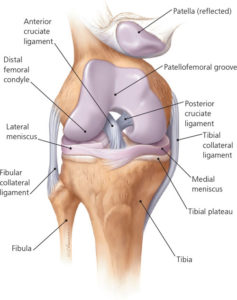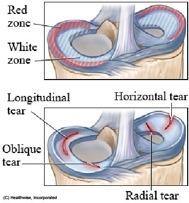What is it?
- The meniscus is a crescent-shaped fibrocartilage structure located within the knee joint
- There is both a medial meniscus located on the inside of the knee and a lateral meniscus located on the outside
- The menisci’s role is to absorb shock and distribute load at the knee joint
How is it caused?
- Most commonly meniscal injuries are from a twisting mechanism
- Can be degenerative or traumatic
- Degenerative tears are more common in the older population but can also be due to repetitive overload
- Traumatic tears are more common with athletes and more commonly medial injuries
Symptoms:
- Swelling and stiffness
- Pain especially when trying to bend or twist the knee
- Knee instability and giving way
- Locking, popping or catching
What can be done to alleviate pain?
- Rest, ice, compression , elevation
- Strapping
- Avoid aggravating activities
- Guided strengthening programme to reduce meniscal overload
- If tear is large may need MRI and onward referral to Orthopaedic surgeon for arthroscopic repair/debridement
 Chances of requiring surgery?
Chances of requiring surgery?
- Depends on size and location of the tear. The meniscus has a poor blood supply; especially in the inner portion so if the tear is small and on the outer portion it will have a better chance of healing
Interesting facts
- The medial collateral ligament of the knee has some attachments to the medial meniscus. It is for this reason, that people may experience a meniscus and ligamentous injury simultaneously
More information
- The menisci have a relatively poor blood supply, with the outer portion, often known as the “red zone”, being the most vascularized. If the tear is small (<3mm) and located on the outer portion of the meniscus it has a better chance of healing than a tear that extends to an area with a poorer blood supply
At Sydney Physiotherapy Solutions our highly qualified physiotherapists specialise in the assessment, treatment and prevention of neuromusculoskeletal injuries.
Contact us today – 9252 5770



